Are you a Quiet Speculation member?
If not, now is a perfect time to join up! Our powerful tools, breaking-news analysis, and exclusive Discord channel will make sure you stay up to date and ahead of the curve.
There are many things I love about Magic. The infinite possibilities that come from access to a diverse card pool, branching decisions trees that spread from one singularity, and the delicate balance of resource management. While each Magic format has its own unique qualities and characteristics, the one attribute of Modern I appreciate most is the importance of mana as a controllable resource, both in deck construction and gameplay.
Below, I’ll define the role resource management plays in Modern, analyze some examples of this principle in practice, and discuss how it applies to Grixis Control, my deck of choice for GP Charlotte. Let’s begin!
[wp_ad_camp_1]
Mana as a Resource
Magic, at its foundation, is a struggle to manage finite resources. Both players start at 20 life, with seven cards in hand (hopefully). Players draw one card and play one land per turn. Life points can be spent and exchanged like any other resource to gain an advantage elsewhere. The same goes for cards, where “card advantage” as we commonly refer to it involves gaining resources or extra value for what we pay (Supreme Verdict vs. a board of opposing creatures). Life as a resource is nonrenewable: once you use it, it’s gone (barring an exchange of resources a la Healing Salve). Cards as a resource is carefully controlled: you only get one new card a turn (barring effects such as Brainstorm). Mana, on the other hand, is given freely. Every turn, on the untap step, the hourglass resets, and all spent mana is refilled, ready to be used again. Whether we have access to two mana or ten, the fundamental rules of Magic allow us to leverage those resources again and again, equal to the amount of mana available multiplied by the amount of turns we play in the game.
We are all familiar with the untap step. What is your point?
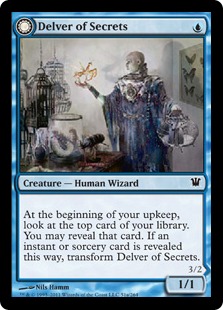 The most successful strategies in Magic’s history have been decks designed to maximize mana efficiency at every stage of the game. This is seen all the time in high-powered formats such as Legacy and Vintage, and occasionally in Standard when the stars align. One classic example of this theory in practice is UW Delver, seen here taking 1st place by Yuuya Watanabe at GP Manilla 2012. Capable of deploying fast, cheap threats as early as the first turn, and then backing them up with counterspells and other protection spells made this deck a formidable force, and the consensus best deck during it’s time in Standard. While everyone remembers Delver of Secrets as the tool that beat them, the most important lesson this deck taught its opponents (whether they recognized it or not) was how incredibly powerful maximizing mana-use can be.
The most successful strategies in Magic’s history have been decks designed to maximize mana efficiency at every stage of the game. This is seen all the time in high-powered formats such as Legacy and Vintage, and occasionally in Standard when the stars align. One classic example of this theory in practice is UW Delver, seen here taking 1st place by Yuuya Watanabe at GP Manilla 2012. Capable of deploying fast, cheap threats as early as the first turn, and then backing them up with counterspells and other protection spells made this deck a formidable force, and the consensus best deck during it’s time in Standard. While everyone remembers Delver of Secrets as the tool that beat them, the most important lesson this deck taught its opponents (whether they recognized it or not) was how incredibly powerful maximizing mana-use can be.
At every stage of the game, UW Delver found ways to maximize its mana usage. Pass turn with mana up and opponent plays around Mana Leak? Flash in Restoration Angel. Have an extra mana or two free? Dig through the deck with Ponder and Thought Scour. Have all the mana in the world? Equip a Runechanter's Pike and get to work. While opponent’s were busy scrambling to answer Delver and playing around counterspells plus Vapor Snag, all UW Delver cared about was maximizing its mana usage, using all available mana on every turn, generating small advantages and leveraging them into larger gains in the areas of tempo and card advantage.
So we get an untap step, and we can use all the mana we want. Got it. But shouldn’t we be casting the biggest thing we can turn after turn? Isn’t that the goal?
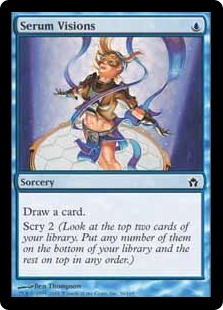 Sure, that’s the goal if you’re playing RG Tron, and your opponent isn’t set up to stop your unfair things. Look, there’s a reason why big, flashy cards seen flying across the table at Standard FNM’s don’t make the transition to Modern and Legacy. In high-powered formats, the cheapest option for an effect is usually the best. That's why, in Modern, Serum Visions is a stronger card than something like Peer Through Depths or Think Twice. Yes, Peer lets you dig two cards deeper into your deck, but Visions costs one less, which is a really big deal. Why? Mana efficiency! The ability to leverage our card resources faster, with greater ease, and fill in the gaps of our curve will translate into greater advantages later in the game.
Sure, that’s the goal if you’re playing RG Tron, and your opponent isn’t set up to stop your unfair things. Look, there’s a reason why big, flashy cards seen flying across the table at Standard FNM’s don’t make the transition to Modern and Legacy. In high-powered formats, the cheapest option for an effect is usually the best. That's why, in Modern, Serum Visions is a stronger card than something like Peer Through Depths or Think Twice. Yes, Peer lets you dig two cards deeper into your deck, but Visions costs one less, which is a really big deal. Why? Mana efficiency! The ability to leverage our card resources faster, with greater ease, and fill in the gaps of our curve will translate into greater advantages later in the game.
Another classic example of mana efficiency is Remand. Sit down against any opponent piloting Big Green Whatever. Both of you have access to five mana, you spend two casting a creature, one casting a card draw spell, and pass with two mana up. Your opponent spends four on a Huntmaster of the Fells, which you answer with your Remand because you’re a Professional Magic Player (a PRO, if you will). Not only did you deal with your opponent’s threat and gained two mana on the exchange (your two-mana Remand for his four-mana Huntmaster), your opponent also wasted a mana by casting only Huntmaster on his turn. Meanwhile, you maximized mana efficiency by gobbling up everything on your plate. Congratulations, you deserve dessert! Keeping this principle in mind during deckbuilding is essential, it’s why I will usually choose a cheap option like Bitterblossom over something like Olivia Voldaren when building decks.
Modern - The Mana Tiers
Whether you’ve noticed it before or not, it bears repeating that Modern is a format defined by mana efficiency. Modern playable spells can generally be organized into four tiers, each looking to accomplish a specific goal. Let’s take a look.
One-mana spells: answers and card selection
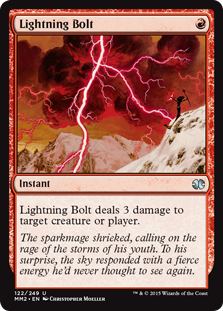 With the exception of green, every color in Magic contains a one-mana answer widely played in Modern decks. Path to Exile, Lightning Bolt, Thoughtseize, Spell Snare; these highly efficient spells establish the baseline for what we “should” be spending to answer threats in Modern. This is why cards such as Go for the Throat and Hero's Downfall don’t see much (if any) Modern play; there are simply better options available for less mana. Why do Abrupt Decay and Terminate see play then? Flexibility, without a drawback! While excellent, Lightning Bolt only hits < 4 toughness threats, and Path to Exile grants your opponent a free land.
With the exception of green, every color in Magic contains a one-mana answer widely played in Modern decks. Path to Exile, Lightning Bolt, Thoughtseize, Spell Snare; these highly efficient spells establish the baseline for what we “should” be spending to answer threats in Modern. This is why cards such as Go for the Throat and Hero's Downfall don’t see much (if any) Modern play; there are simply better options available for less mana. Why do Abrupt Decay and Terminate see play then? Flexibility, without a drawback! While excellent, Lightning Bolt only hits < 4 toughness threats, and Path to Exile grants your opponent a free land.
As for card selection, Serum Visions exists as the last man standing for cheap card draw, as Ponder and Preordain are banned. Establishing this baseline for cheap answers and card draw allows us to evaluate rate for individual cards. Ancient Stirrings seems like a weak option compared to Serum Visions, but when we factor in synergy and the “puzzle piece” factor, we might start to re-evaluate cards like Stirrings.
Two-mana spells: threats and more threats
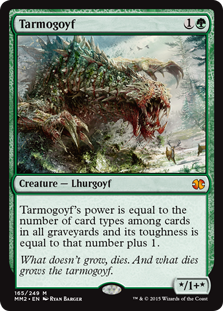 Tarmogoyf. Dark Confidant. Young Pyromancer. Eidolon of the Great Revel. Voice of Resurgence. Two mana in Modern grants you a resilient threat, barring outliers like Monastery Swiftspear and Delver of Secrets. Not counting the hyper-aggressive linear strategies, most threats in Modern are costed around two mana. This is important because, as with the one-mana tier of answers, two-mana threats establishes the baseline for what we “should” be paying for a threat in Modern. This is why creatures like Loxodon Smiter and Knight of the Reliquary don’t see much play, regardless of how many times Brian Kibler tries to make them work. Paying an extra mana for some counterplay against discard or land-based synergies often isn’t powerful enough to justify the extra resource investment, which is why Smiter and friends don’t see wider play. This push towards two-mana threats also has an interesting effect on counterspells in the format. Cards like Mana Leak, Deprive, and Remand see play, but not to the extent of Lightning Bolt and Path to Exile because a lot of things have to go right for these counterspells to be considered “good”.
Tarmogoyf. Dark Confidant. Young Pyromancer. Eidolon of the Great Revel. Voice of Resurgence. Two mana in Modern grants you a resilient threat, barring outliers like Monastery Swiftspear and Delver of Secrets. Not counting the hyper-aggressive linear strategies, most threats in Modern are costed around two mana. This is important because, as with the one-mana tier of answers, two-mana threats establishes the baseline for what we “should” be paying for a threat in Modern. This is why creatures like Loxodon Smiter and Knight of the Reliquary don’t see much play, regardless of how many times Brian Kibler tries to make them work. Paying an extra mana for some counterplay against discard or land-based synergies often isn’t powerful enough to justify the extra resource investment, which is why Smiter and friends don’t see wider play. This push towards two-mana threats also has an interesting effect on counterspells in the format. Cards like Mana Leak, Deprive, and Remand see play, but not to the extent of Lightning Bolt and Path to Exile because a lot of things have to go right for these counterspells to be considered “good”.
 Take the Remand example from earlier. The PRO player was able to generate advantages both in tempo and mana efficiency because he was able to answer his opponent’s four-mana threat with two mana at instant speed, while using the rest of his turn to accomplish other goals. Mana Leak on Tarmogoyf is acceptable, yet we are still trading two mana for two mana, and not gaining an advantage (a push, if you will). Mana Leak exists as a playable spell in the format because of its broad applications. Similar to Abrupt Decay, it can answer a wide range of threats both early in the game and late. The issue with Leak (and most two-mana counterspells in Modern) is that most threats in Modern are two mana, so it becomes much more difficult to generate an advantage with them, not to mention their inability to deal with two-mana threats while on the draw. Leak in particular suffers from a narrow window of effectiveness, as it cannot answer opposing threats at the start to the game, and can be played around a few turns down the line once mana has been developed. This is why Spell Snare is such an important card, a functional Path or Bolt that can answer Tarmogoyf, Bitterblossom, Terminate, and opposing counterspells even on the draw.
Take the Remand example from earlier. The PRO player was able to generate advantages both in tempo and mana efficiency because he was able to answer his opponent’s four-mana threat with two mana at instant speed, while using the rest of his turn to accomplish other goals. Mana Leak on Tarmogoyf is acceptable, yet we are still trading two mana for two mana, and not gaining an advantage (a push, if you will). Mana Leak exists as a playable spell in the format because of its broad applications. Similar to Abrupt Decay, it can answer a wide range of threats both early in the game and late. The issue with Leak (and most two-mana counterspells in Modern) is that most threats in Modern are two mana, so it becomes much more difficult to generate an advantage with them, not to mention their inability to deal with two-mana threats while on the draw. Leak in particular suffers from a narrow window of effectiveness, as it cannot answer opposing threats at the start to the game, and can be played around a few turns down the line once mana has been developed. This is why Spell Snare is such an important card, a functional Path or Bolt that can answer Tarmogoyf, Bitterblossom, Terminate, and opposing counterspells even on the draw.
Three-mana spells: card advantage
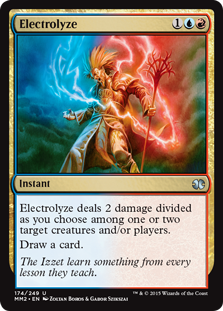 This category includes cards like Electrolyze, Kolaghan's Command, Liliana of the Veil, Lingering Souls, and Kitchen Finks. If one mana gets us answers and two mana presents threats, it stands to reason that playable three mana spells should offer something more. All of the above cards generate card advantage in some way, either by answering a threat at no loss of card quality (Electrolyze), generating a built-in two for one (Kolaghan's Command), or functioning as “more than a card” through Lingering Souls' flashback and Liliana's resiliency. This trend towards three-mana spells as card advantage explains why things such as Maelstrom Pulse and Detention Sphere see little play. More often than not, these spells function as expensive three-mana answers that don’t generate any advantage (Maelstrom Pulse against Bitterblossom, Detention Sphere against Keranos, God of Storms) where a one- or two-mana spell could have done the job.
This category includes cards like Electrolyze, Kolaghan's Command, Liliana of the Veil, Lingering Souls, and Kitchen Finks. If one mana gets us answers and two mana presents threats, it stands to reason that playable three mana spells should offer something more. All of the above cards generate card advantage in some way, either by answering a threat at no loss of card quality (Electrolyze), generating a built-in two for one (Kolaghan's Command), or functioning as “more than a card” through Lingering Souls' flashback and Liliana's resiliency. This trend towards three-mana spells as card advantage explains why things such as Maelstrom Pulse and Detention Sphere see little play. More often than not, these spells function as expensive three-mana answers that don’t generate any advantage (Maelstrom Pulse against Bitterblossom, Detention Sphere against Keranos, God of Storms) where a one- or two-mana spell could have done the job.
On the other hand, this is why Snapcaster Mage is, in my opinion, the best individual card in Modern. Snapcaster functions as a modal spell that can be cast as either a cheap, unassuming 2/1 flash creature for two, or can be cast for three (or more) to rebuy previously cast spells again and with a 2/1 attached. Snapcaster's value appreciates as the game lengthens, which cannot be said for any other card I can think of. On turn three, Snapcaster can rebuy a Lightning Bolt. On turn six, it can rebuy a Cryptic Command. So when it comes to three-mana card advantage spells, the two-mana Snapcaster is the undisputed king.
Four-mana: win the game
Building on the principles established in previous tiers, a four-mana investment should naturally provide something well worth the price. That means Cryptic Command, Supreme Verdict, Shatterstorm, or Splinter Twin. In Modern, four mana often occupies an entire turn’s worth of mana. The prevalence 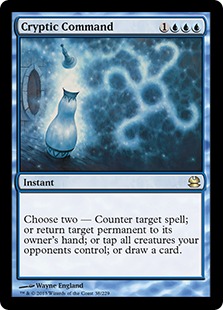 of highly efficient threats and answers in the format, along with counterspells, means if you intend to spend four mana on a spell, it better win the game. It can also generate a significant enough advantage that the opponent should have difficulty moving the game back to parity. In addition, the presence of Splinter Twin strategies along with other fast combo decks work to push curves lower, as tapping out for a large spell can often “spell” doom (sorry: had to) if it doesn’t end the game on the spot. As I said earlier, many players suggest Olivia Voldaren as a possible option for Jund and Grixis decks, but a four-mana 3/3 that takes over the game only if you can untap with it is a pretty large investment risk, especially in a format full of one-mana removal like Bolt and Path. Jund strategies seem to be the only decks that can employ expensive spells like Huntmaster and Outpost Siege (gross) that don’t immediately end the game, because the rest of their deck works to guide the game towards a topdeck war where both of these threats excel at generating advantages and burying the opponent.
of highly efficient threats and answers in the format, along with counterspells, means if you intend to spend four mana on a spell, it better win the game. It can also generate a significant enough advantage that the opponent should have difficulty moving the game back to parity. In addition, the presence of Splinter Twin strategies along with other fast combo decks work to push curves lower, as tapping out for a large spell can often “spell” doom (sorry: had to) if it doesn’t end the game on the spot. As I said earlier, many players suggest Olivia Voldaren as a possible option for Jund and Grixis decks, but a four-mana 3/3 that takes over the game only if you can untap with it is a pretty large investment risk, especially in a format full of one-mana removal like Bolt and Path. Jund strategies seem to be the only decks that can employ expensive spells like Huntmaster and Outpost Siege (gross) that don’t immediately end the game, because the rest of their deck works to guide the game towards a topdeck war where both of these threats excel at generating advantages and burying the opponent.
As a final note, Collected Company exists as a four-mana card advantage spell that requires lots of support to make it work. Decks casting Company basically have to hit two creatures to not fall behind on-rate. Even then, cards such as Lingering Souls can more-or-less do the same thing without having to jump through hoops. While the ability to dig through the deck has applications as far as searching for sideboard cards and combo pieces go, there’s a reason Collected Company is always seen alongside mana creatures.
Grixis Control and GP Charlotte
With these principles in mind, I began preparation for Grand Prix Charlotte knowing I wanted to find a strategy that worked within these established tiers of Modern mana investment. Grixis Delver was an established strategy that I felt was doing a lot of things right, and Tasigur, the Golden Fang and Kolaghan's Command seemed to add a lot of play to the strategy. The core of Serum Visions, Lightning Bolt, Snapcaster Mage, and Thought Scour was incredibly powerful, and I knew any deck I was going to play would be packing four Snapcaster Mages.
Grixis Delver, by Trevor Holmes
After testing a few games with this deck, I found my Delvers and Young Pyromancers were underwhelming, while Tasigur continued to overperform. As a huge threat that came down for usually one or two mana with barely any conscious work to enable him, Tasigur was just excellent. In Grixis he functions as a black Tarmogoyf that draws cards, can’t be shrinked, and dodges Abrupt Decay. When I started cutting Delver of Secrets in post-board blue matchups and against removal-heavy opponents, I started leaning more heavily on Tasigur. That's when I knew I needed to make a change.
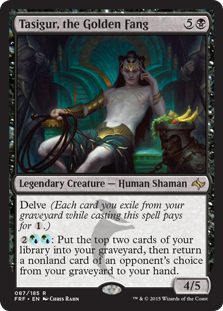 Cutting Delver allowed me to also cut Gitaxian Probe. While a perfectly fine card, Probe puts a little too much stress on our life total and is not something I want to be doing when facing Burn or Affinity, so cutting them was not something I found too painful. While on one hand removing Probe can make Snapcaster slightly worse (running him out turn two while flashing back a Probe is an excellent play) cutting Probe made my draw steps and Thought Scours more powerful. So as far as Snapcaster goes, I’d call it a push. And once you’re cutting Delver and Probe, Pyromancer starts to not look so hot. Remand also becomes less amazing when we’re not looking to apply quick pressure or protect a combo on a pivotal turn.
Cutting Delver allowed me to also cut Gitaxian Probe. While a perfectly fine card, Probe puts a little too much stress on our life total and is not something I want to be doing when facing Burn or Affinity, so cutting them was not something I found too painful. While on one hand removing Probe can make Snapcaster slightly worse (running him out turn two while flashing back a Probe is an excellent play) cutting Probe made my draw steps and Thought Scours more powerful. So as far as Snapcaster goes, I’d call it a push. And once you’re cutting Delver and Probe, Pyromancer starts to not look so hot. Remand also becomes less amazing when we’re not looking to apply quick pressure or protect a combo on a pivotal turn.
At this point I knew I wanted to play more of a Grixis Control type strategy, with more Tasigurs and no Delvers. I liked that a lot of pros were writing articles about Grixis, and I was looking forward to blanking opposing Decays in G1’s, and bringing in Blood Moon or Bitterblossom after board. After making some changes and incorporating some ideas from Patrick Chapin’s excellent Sultai/Grixis article (SCG premium), I arrived at the following list.
Grixis Control, by Trevor Holmes (GP Charlotte 2015)
This list was exactly what I wanted to be doing in Modern, and where I wanted to be for Charlotte. Gurmag Angler as extra copies of Tasigur really brought the deck together and gave it an actual gameplan. Pure control is difficult to accomplish in Modern, as there is just too much discard and too many wacky things to be able to control everything. Shaun McClaren can win with Jeskai, but normal humans seem to have some difficulties. As a result, I wanted my Grixis “Control” deck to be able to turn the corner quickly when ready, and there’s no better way to do that than one-mana 4/5’s and 5/5’s. Bolts and Kolaghan's Command-Shocks also work better at killing our opponent if we’ve hit him for four or five once or twice, and the removal of Delver and Probe allows us to play Creeping Tar Pits, up our individual card quality and settle in for the long game.
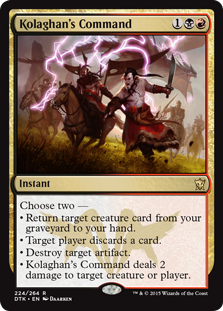 Coming off of the Season Two Invitational, big mana decks such as Amulet Bloom and RG Tron seemed like they would be popular due to their recent success. For Charlotte, I expected a field consisting primarily of big mana decks, fair decks tuned to fight the big mana decks, fast aggro decks looking to capitalize on everyone tuning their decks to fight the big mana decks, and Twin. I knew Kolaghan's Command would be excellent against everyone, as the Snapcaster/Command loop buries all the fair decks and Command is an amazing two-for-one against Affinity and Burn as well. Even against the big mana decks, snagging an Amulet of Vigor or Expedition Map is fine and can help us steal a victory. Like most everyone else with access to red, I planned on packing Blood Moon in large numbers to fight Amulet and Tron, both tough matchups. For everyone else, Snapcaster and Tasigur supported by cheap interaction and Kolaghan's Command to keep things going would be strong enough against to give me game in every matchup.
Coming off of the Season Two Invitational, big mana decks such as Amulet Bloom and RG Tron seemed like they would be popular due to their recent success. For Charlotte, I expected a field consisting primarily of big mana decks, fair decks tuned to fight the big mana decks, fast aggro decks looking to capitalize on everyone tuning their decks to fight the big mana decks, and Twin. I knew Kolaghan's Command would be excellent against everyone, as the Snapcaster/Command loop buries all the fair decks and Command is an amazing two-for-one against Affinity and Burn as well. Even against the big mana decks, snagging an Amulet of Vigor or Expedition Map is fine and can help us steal a victory. Like most everyone else with access to red, I planned on packing Blood Moon in large numbers to fight Amulet and Tron, both tough matchups. For everyone else, Snapcaster and Tasigur supported by cheap interaction and Kolaghan's Command to keep things going would be strong enough against to give me game in every matchup.
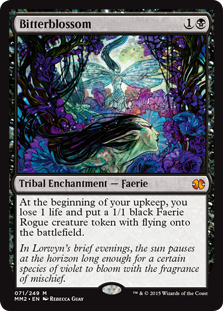 As for the rest of my board, I knew I wanted a trump for the blue mirrors, even if probably not necessary to win games. I didn’t have enough time to test the intricacies of the matchup and wanted something my opponents wouldn’t be prepared for. There is a fine line between “trump” and “too cute”, but I’ve found success by bringing something new to the table that my opponent isn’t expecting. I say all this to preemptively defend my decision to run two Bitterblossoms in the board, as I knew it was a topic of contention while testing on stream (twitch.tv/Architect_Gaming!) and I would have to explain it to salty opponents as well. In a Delverless Grixis Control deck, Game 1’s often ended by with me gaining virtual card advantage due to opponent’s being stuck with semi-dead Decays and Bolts they have to send at my face while I’m clocking them with Gurmag Angler. After board, I expected many opponents to board out Decay, at which point I would be boarding in Blood Moon or Bitterblossom in the blue mirrors and Jund matchups. While my opponents were preparing to settle in for a long game, using their first few turns to play tapped lands of their own and cast some Serum Visions, I was casting Inquisition of Kozilek into Bitterblossom and leaving them dead in the water.
As for the rest of my board, I knew I wanted a trump for the blue mirrors, even if probably not necessary to win games. I didn’t have enough time to test the intricacies of the matchup and wanted something my opponents wouldn’t be prepared for. There is a fine line between “trump” and “too cute”, but I’ve found success by bringing something new to the table that my opponent isn’t expecting. I say all this to preemptively defend my decision to run two Bitterblossoms in the board, as I knew it was a topic of contention while testing on stream (twitch.tv/Architect_Gaming!) and I would have to explain it to salty opponents as well. In a Delverless Grixis Control deck, Game 1’s often ended by with me gaining virtual card advantage due to opponent’s being stuck with semi-dead Decays and Bolts they have to send at my face while I’m clocking them with Gurmag Angler. After board, I expected many opponents to board out Decay, at which point I would be boarding in Blood Moon or Bitterblossom in the blue mirrors and Jund matchups. While my opponents were preparing to settle in for a long game, using their first few turns to play tapped lands of their own and cast some Serum Visions, I was casting Inquisition of Kozilek into Bitterblossom and leaving them dead in the water.
In Charlotte, I went 7-1-1 on Day 1, beating Faeries, Elf Company, Burn, Jund, Little Kid Abzan, Jeskai Control and Grixis Twin, while losing to Affinity and drawing with Amulet Bloom. Most of my matches were not close and six of my seven wins were 2-0. On Day 2, I took an early loss to Etched Champion again, beat another Grixis Twin deck (2-0), then lost two weird games to UW Sun Titan Control and Jund to finish my Day 2 run. My opponents were constantly confused as to the makeup of my deck, and several times I had opponents ask me after the match if I was playing Delver or the combo. Shadow of Doubt is often boarded out after game 1’s along with Mana Leak, but I “got em” a few times over the course of the event, and it does enough against big mana and Chord of Calling that I feel it's earned its slot. I’m not against cutting it either. Many viewers of my stream have suggested Olivia Voldaren instead of Bitterblossom against Jund and other decks. My response has always been the same: I’ll take the cheap, efficient, hard to deal with threat over a four drop that dies to Lightning Bolt everytime.
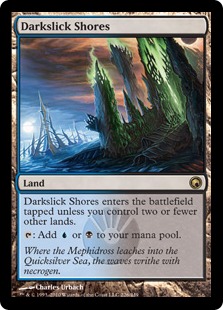 A few matches into Day 1, I knew my list was a few cards off from perfect. I swapped my 4th Island for a Darkslick Shores in an attempt to support my two maindeck Inquisition of Kozileks, but this in turn made my manabase worse when trying to operate under Moon. This was done in an attempt to play early discard without losing much life against Affinity and Burn, while having another blue dual like Creeping Tar Pit that gets to untap under Choke. But the Shores should probably just go back to being an Island.
A few matches into Day 1, I knew my list was a few cards off from perfect. I swapped my 4th Island for a Darkslick Shores in an attempt to support my two maindeck Inquisition of Kozileks, but this in turn made my manabase worse when trying to operate under Moon. This was done in an attempt to play early discard without losing much life against Affinity and Burn, while having another blue dual like Creeping Tar Pit that gets to untap under Choke. But the Shores should probably just go back to being an Island.
I moved a Kolaghan's Command to the board to fit discard in the main, and boarded in the Command almost every time in exchange for the Shadow of Doubt after game 1. This was done under the reasoning that Shadow is really a game 1 card and better on the play, and I often was boarding it out when on the draw (which most of my game 2’s were on the draw over the course of the event). After making the swap all event, I realized I should just cut the Shadow, move the Kolaghan's Command maindeck and free up a sideboard slot to help out a bad matchup.
Dragon's Claw in the board should probably just be Dispel. Claw is excellent against Burn but Dispel is almost as good, gaining anywhere from 3-8 life just like Claw would normally, while allowing me to continue to be immune to Destructive Revelry. In addition, Dispel is excellent against opposing Cryptic Commands, so much so that I’ve been cutting my own Cryptics in blue mirrors that I’d like to have access to the extra counterspell.
Post GP Charlotte Grixis Control
I’d like to close by talking about this Cryptic Command issue a little more, along with some discussion on my updated decklist and how it compares to Patrick Chapin’s 9th place list at the Charlotte. See the list below:
Grixis Control Revised, by Trevor Holmes
I found myself cutting Cryptic Command in blue mirrors, as I found I was rarely able to use it safely and often had to cast it on turn four to protect a creature, rather than later in the game when I could support it with Spell Snare and Deprive. My reasoning was that I would rather be the player casting Dispel on my opponent’s Cryptic rather than the other way around, and I eventually trimmed down to just one copy for my final list. Pat placed 9th on breakers with a very similar Grixis control list, playing Fulminator Mage over Blood Moon and cutting the Young Pyromancers and Shadow of Doubt for a full playset of Cryptics. Many viewers on stream asked if I would be switching to his list and what I thought about it, so I figured I’d give my perspective here in writing.
 First and foremost, Patrick Chapin is an excellent player and I’m probably a tenth of the player he is, which is why I probably wouldn’t do well with his list. Though they are only a couple cards off, Chapin’s decision to cut Pyromancers and max out on Cryptics shows a strong predisposition to stretching the game out as long as possible. Similar to the way a Jeskai Control deck would operate, I imagine all Pat wanted to do over the course of the weekend was find opportunities to cast Cryptic for value, burying his opponent once he was able to fire off two or three. I play better when providing pressure, which supports my decision to retain Pyromancers in my list, and I feel that you can find success either way. I would be much happier to be casting Cryptic Command if I had more Dispels to protect it, and if I decide to cut the Young Pyromancers I would probably replace them with Cryptics for sure.
First and foremost, Patrick Chapin is an excellent player and I’m probably a tenth of the player he is, which is why I probably wouldn’t do well with his list. Though they are only a couple cards off, Chapin’s decision to cut Pyromancers and max out on Cryptics shows a strong predisposition to stretching the game out as long as possible. Similar to the way a Jeskai Control deck would operate, I imagine all Pat wanted to do over the course of the weekend was find opportunities to cast Cryptic for value, burying his opponent once he was able to fire off two or three. I play better when providing pressure, which supports my decision to retain Pyromancers in my list, and I feel that you can find success either way. I would be much happier to be casting Cryptic Command if I had more Dispels to protect it, and if I decide to cut the Young Pyromancers I would probably replace them with Cryptics for sure.
What do you think? Do you agree with my decision to trim Cryptic Command? What about my classification of Modern’s mana tiers? Is there anything you would change in my list? Thanks for reading and let me know in the comments!
Trevor Holmes
The_Architect on MTGO
Twitch.tv/Architect_Gaming
Twitter.com/7he4rchitect


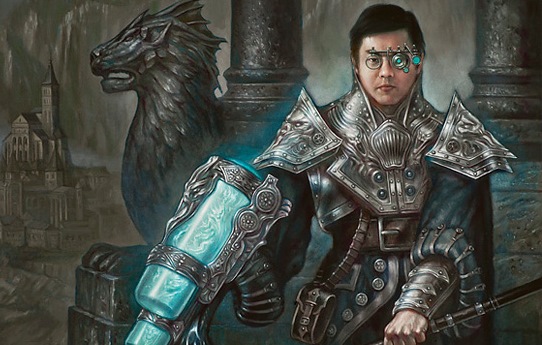




Thank you for the most interesting article.
Thanks! I’m glad you liked it!
Awesome article, now play Twin and quit messing around lol.
Very nice article and insight on the format for it’s growing community.
Great article, just one thing that I was wondering about. You have an electrolyze in the deck, but outside of the company decks, is there much reason to run that over an additional kolghans command? It seems like you still get to kill any of the problem creatures, but the value of commands other modes seems superior to the simple draw a card from electrolyze.
The card advantage provided by Lingering Souls is a big problem for this deck, as outside of Kolaghan’s Command I have to spend an entire card to deal with one token. I would consider Kolaghan’s Command slightly stronger, yet I don’t mind the 3/1 split and there are definitely situations where Electrolyze is better
Nice info. I would like to see a per match breakdown if you have one. I gain a lot of insight on your goal against each match-up. thanks for writing this!
Thanks for the suggestion, this is in the works!
Cool article, though I am a bit curious as to why you chose to drop Shadow of Doubt, when most estimations of what went on in the GP (including one on this very site) have touted it as one of the pieces of “hot tech” to come out of the tournament. Was the impact of landing one simply not sufficient to justify its inclusion? Were you having opponents sit on your fetch triggers on Games 2 and 3 in order to avoid it? Do you think it’d be more useful as disruption tech in a mono-colored deck that doesn’t rely on fetches and is looking for a tempo advantage, such as Merfolk? I’d love to hear your thoughts on this.
Shadow of Doubt is such an interesting card. On one hand, I have a personal bias towards the card as I love a grindy trick that cycles, is never dead, and can occasionally be amazing. That said, it’s more of a Game 1 card, as its value goes down significantly once your opponent knows about it. Add to this the fact that it’s actively bad against the aggressive decks and it becomes to easy to justify taking it out. In a highly stable metagame of just big mana decks and blue mirrors I would like this effect, but if I had extra room I would play the 4th Terminate or 3rd Spell Snare over it. As for playing it in other decks, the card is always just fine, sometimes just bad, and occasionally perfect. Sometimes I want it, most of the time I don’t.
Thanks for the answer. I’m thinking I’ll take it out for a spin in my Merfolk deck, and see how it does. I think it’s a good fit because I can keep the mana open for it while still pressuring my opponent, and if it acts as a virtual Sinkhole (or better yet, stuffs a removal spell by disallowing my opponent to fetch the land he needs to cast it), the tempo loss can be backbreaking.
Really great article! More from this author please. This helped bring clarity to some plays that I’ve instinctually felt are “the right play” but haven’t necessarily known exactly why.
This helped bring clarity to some plays that I’ve instinctually felt are “the right play” but haven’t necessarily known exactly why.
One question: GerryT has made Leyline of the Void the new hotness for Jund. Do you think there’s any reason to consider it for a deck like this, or is that card not for this style of deck? Just curious, not sure it’s any good at all.
Leyline of the Void is a fine card for the Jund deck, for a couple of reasons. One, it has applications in other matchups (Living End, Abzan Combo) along with its main purpose, to fight Grixis and all the Delve running around. Jund as a strategy is focused on running opponents out of cards, and then topdecking better or finding some way to pull ahead with Dark Confidant, manlands, and Liliana. Kolaghan’s Command, Delve, and Snapcaster Mage fight Jund on an axis that it needs to respond to, or it won’t be able to successfully grind.
As for us, we don’t care so much about our opponent trying to grind, as hopefully we are well prepared to fight on that axis. Maybe if the field was all graveyard synergies we would want something like this, but if that was the case we probably wouldn’t be playing this deck.
Trevor is currently on our writer onboarding track. Expect to see more of his content every week for a bit, hopefully culminating with an announcement about him being added as a full staff writer!
amen! it’s about time someone sets a couple of things straight
of course Snapcaster is the most powerful card in Modern! imo that’s a trick question to understand how much does the person you speak to grasps, if he picks Tarmogoyf you know he just picked the most expensive card
also good job on giving Grixis the attention it deserves, it’s such a wonderful color combination, a joy to play both with and against and now for the first time in Modern’s history it seems to pack Tier 1 power level.
Just to play devil’s advocate here:
Snapcaster Mage is the most versatile card in Modern, and depending on your deck design on of _your_ most powerful cards.
BUT Tarmogoyf is the outright most powerful card in Modern, oh wait no that’s Emrakul (there’s a reason Tron ramps into Emrakul and not Goyf). In most cases Tasigur is a better card than Goyf (a 4/5 with an activated ability, vs a 4/5)
Tarmogoyf is the most obscene card in Modern though (and I’m not just talking about price). The games were Tarmogoyf lands on turn 2, compared to the ones where he doesn’t are completely different – it’s similar with Delver, if it flips on turn 2.
You can play around Snapcaster Mage a lot more than you can around Tarmogoyf, Tarmogoyf says deal with me or die, Snapcaster Mage is more of a find an answer card. And I value proactivity over reactivity in Modern.
That said there’s a reason Grixis (and to a lesser extent BUG) Control can exist, and it’s because Snapcaster Mage allows for answers while Tasigur (and Tarmogoyf) allow for low mana must deal with threats. Just as Patrick Dickmann about the feel bads when your opponent lands a turn 2 Tasigur…
I really liked the classification of mana tiers and I think you’re spot on. Content like that is what keeps me coming back to the site.
Thanks! I’m glad you liked the article!
Love the article, keep up the good work!
Great article, although I think you missed something in the mana tiers: you did not mention mana dorks, which make 3-mana threats much more playable and allow a different curve
Interesting point, I did speak to how Collected Company in particular is a four-mana value card that is only playable alongside mana creatures. Possibly I could talk more about this in a future article. Thanks for pointing that out!
Interesting article and I like the take-away from it. One way to look at this is in the context of the ‘perfect’ curve for your deck so if I look at the ultimate ‘fair’ deck you get:
BGx – Turn 1; Discard/Bolt, Turn 2; Goyf/Bob, Turn 3; Liliana
Or, Answer, Threat, Advantage
After that you just ride home your board state with removal/discard and Liliana activations.
And then you compare it to my preferred deck (Splinter Twin)
Twin – 1; Visions/Bolt, 2; Remand, 3; Exarch, 4; Twin
Answer/Dig, Answer, ???, Win
So let’s look at these in context of certain deck choices.
Jund vs. Junk – Junk gives up Lightning Bolt (and to a lesser extent Kolaghan’s Command) for Siege Rhino and Lingering Souls. What does that mean for Junk – well it’s turn 1 play is diluted. It only has a pre-emptive answer to a Turn 1 dork (sorry if you’re on the draw). It also overloads on the 3-drop space (where Liliana is the preferred play), at times it even runs Kitchen Finks. Jund is clearly the favourite here because it has more to do on turn 1 (and that’s probably even more important than the fact that it’s Lightning Bolt – rather that it’s something).
Twin (and all its variants) – so UR Twin was the dominating version at GP Charlotte (2 decks in top 8). So what is it doing right? It doesn’t have a great Turn 2 play (Remand is great if you Turn 1 Delver, less so when you have no board presence), it’s Turn 3 play is wait and see but on Turn 4 it wins the game (i.e. the best 4 mana spell in Modern).
Which takes me back to my preference – RUG Twin. RUG Twin has a definitive Turn 2 play, Tarmogoyf. Now you have threat on board, now your opponent is on the back foot. For RUG Twin the perfect curve goes:
Turn 1; Visions, Turn 2; Tarmogoyf, Turn 3/4 – beat face with Goyf, and if you think of tapping out to answer the Goyf – I win.
Grixis can do something similar with Thought Scour into Tasigur, and you’ll probably find those are the best hands for the deck.
The Turn 2 play, the looking at my perfect curve, understanding the need/desire to do something early to put pressure on my opponent makes me pick RUG Twin over the other variants. And I think in Bitterblossom, you’re attempting to fill that hole in the Grixis shell (this is an observation not a down-play of the card, I think it’s a good choice).
You make some good points, the natural “curving out” draws in Modern that we normally talk about in Limited follow the mana tiers I presented; Answer into Threat into Advantage. I would agree that based on your analysis Jund has a much better curve than Abzan, the difference being that Jund has a tough time answering particularly Lingering Souls. Abzan works to overcome the “clunkier” curve by playing slightly farther up the curve and focusing on individual card quality. Where Jund goes Bolt/Discard into Goyf into Liliana, Abzan goes Goyf into Souls into Rhino. When you look at what each deck is doing I would rather be on the Abzan side of that matchup, even though the deck seems to violate some of the guidelines we talked about. Definitely interesting!
I think the answer to this is that in the Midrange mirror – the guy that goes bigger has the advantage (I recall someone running a Grave Titan in the sideboard for just such an occasion – Sigarda is an option for Junk). Having a turn 4 play like Siege Rhino is Abzan’s trump in the mirror.
But that’s for one match-up, and midrange mirrors are definitely not the norm in Modern. If we look across the entire field, Junk’s inability to profitably interact on turn 1 (specifically in light of all the Collect Call decks) is probably the main reason it’s fallen out of favour (that and KolCom). Trading a spell to turn a mana dork into a land is a really bad turn 1 play.
Overall I think we agree – my intention was never to disagree but rather to highlight an alternative way of looking at the same thing – and there will always be exceptions (as an example the Rule of 9 for deck building – it’s a great start, but eventually you realise when and why you should break that rule). Twin breaks the turn 2 and even turn 3 rule proposed, in exchange it gets a turn 4 win, Boggles and Infect spend their turn 1 deploying a threat, etc
Not much to add to the discussion, just wanted to say great work with the whole website and keep it up!
Glad you are enjoying the site! We are very happy with the initial response to Trevor’s article, so let us know if this is content you would continue wanting to see in the future.
Yes, Swords to Plowshare was the best one casting cost thing that I learned back in mid 90’s when the Wiseman control deck was around. Plow, Erhmn Djinn. Because lets say you have a counterspell and plow, and you are wondering if you should counter their creature threat. No, because the plow will take care of it, for 1 less mana, and then the counter spell is still available for later.
This guy can write, plus his stream is top notch =]
Hey guys, great article. Thanks for taking the time to talk about rresource management. now that frindge decks are all the rage, I was wondering if you might speak a bit on a few cards I’m curious to get your opinion on…
Thalia, Guardian of Thraben
suppression field
ghostly prison
grand arbiter agustin IV
I have a certain draw to these cards since they “change the rules” and lean the resource battle heavily in your favor. But I understand why they aren’t mainstream in the the current meta.
The mana tiers are an interesting idea. I’d love to see it explored more thoroughly in the future, including cards such as 1 mana accelerators (creatures as well as Utopia Sprawl) and Expedition Map.
Also, while clearly not as ubiquitous as the other 4 cards, could we consider Nature’s Claim the Green 1 mana answer card?
Well written article!
Just some small thoughts (and a little bit critique):
As some guys mentioned it earlier, you missed Mana dorks, which are increasing the curve cap by 1. That’s why decks like value/Angle Pod could exist (beside that Pod costed only 3), they could play the same game as the classic Midrange decks (BGx) when they didn’t had Pod in game, simply because they were able to cast their threads on time (and most of the times 1 turn earlier than BGx, because of the ramp). Pod and Township were just two ways to use the Manadorks beside the ramp (that’s why DRS was so good in the deck (but DRS is just broken overall)).
Compared the old Pod decks with the CoCo decks, they share the same thought, being able to go bigger than the BGx decks earlier in the game with the manadorks. And as you said, going slightly bigger in a fair match-up increases your win chance by a large margin.
This part would have been awesome (so, the relevance of Mana Dorks in different decks) in your article.
The second point is manlands. Some small thoughts/words on those cards would have been fitting, because they are something like a 1 drop (because they come into play tapped), while providing a finisher in the mid to late game (so basically are a 4 drop in that case).
In the end, a really really well written article, easy to read, easy to understand and gives you an important insight of maybe the most important thing in magic, your manacurve :D. Furthermore, the article reminded me, why the original Sligh deck was so good, cause people never know how good it was to be able to use your mana to 100% every turn.
Greetings,
Kathal
PS: PLS MOAR
You need to do more content, this is by far the most interesting piece I’ve read here. Since the way I see it, highly-interactive Grixis controlling decks are the way to go I’d love to see skilled players dip more into the Chapin side of the meta and explore different ways to build the decks. If I can beat people with Grixis Mentor (yes I did just say Grixis Mentor), then I think it’s safe to say the shell has enough raw power to deal with pretty much anything.
Have you done testing on the mirror match and how did it go?